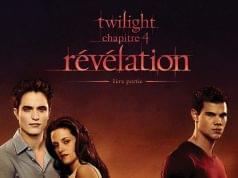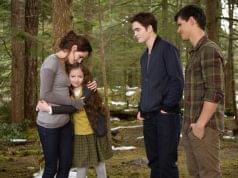Bella Swan’s problem, and the thing that makes her so enviable to many of her adolescent female fans, is that there are two strong, handsome young men deeply in love with her, both of them willing to die for her. Is this not the epitome of the classic romantic melodrama? What teenage girl wouldn’t want to be her? As far as the target audience is concerned, the only way it could be better is if there were three boyfriends instead of two. Of course, the third one would have to be a zombie or something.
Bella (played by Kristen Stewart) has another problem that pops up a lot in “New Moon,” the first sequel to the squeal-inducing “Twilight”: these guys love her so much that they keep telling her to stay away from them for her own good. Edward Cullen (Robert Pattinson), as you already know, is a vampire who can barely resist the urge to gorge himself on a feast of her blood. Jacob Black (Taylor Lautner), as you also already know but aren’t supposed to until well into this film, becomes a werewolf when he gets angry. Vampires and werewolves hate each other anyway, but especially when they’re in love with the same girl. Isn’t it romantic? Swoon.
These are not supernatural movies. I cannot stress that enough. They are teen romances that happen to have supernatural elements. Stephenie Meyer’s novels — or at least the first one, which is all I’ve read — make no attempt to hide this fact, and the two movies so far are likewise pretty straightforward about their intentions. If you come out of “New Moon” wishing there’d been more vampire mythology or werewolf science-fiction, that’s your problem, not the movie’s.
This is unlikely, however. If you go into “New Moon” in the first place, willingly and of your own accord, the odds are very good that you are a fan of the book series, and that you are female, and that you are eager to see a somber, gothic love story. It’s not for nothing that Bella’s English class is studying “Romeo and Juliet.” (According to Hollywood law, this means that specific plot elements of “Romeo and Juliet” must subsequently come into play in the lives of the characters.) I think the movie will probably give you what you’re looking for — which isn’t to say it’s a great movie, only that it’s basically successful at achieving the not-very-lofty goals it sets for itself.
“Twilight” (2008) B-
My Rejected ‘Twilight’ Screenplay
“New Moon” (2009) C+
My Rejected ‘New Moon’ Screenplay
“Eclipse” (2010) B
My Rejected ‘Eclipse’ Screenplay
Five Product Ideas Better Than Bella Swan’s Engagement Ring
“Breaking Dawn — Part 1” (2011) B-
My Rejected ‘Breaking Dawn — Part 1’ Screenplay
“Breaking Dawn — Part 2” (2012) B-
My Rejected ‘Breaking Dawn — Part 2’ Screenplay
Dear ‘Twilight’: Thank You for Ending
The story begins on Bella’s 18th birthday, a reminder that she is getting older while her boyfriend remains forever 17. What will happen when she is elderly and haggard and Edward is still pasty-faced and adolescent? Bella’s proposed solution to this problem is that Edward vampirize her, which he opposes on the grounds that being a vampire means losing your soul, which evidently is bad. Still, he cannot bear the thought of living without her. If he ever lost her, he says, he would commit suicide by going to the Volturi, an ancient race of hardline vampires, and provoking them into executing him. In the business, we call this sort of casual reference OBVIOUS FORESHADOWING.
After an unfortunate paper-cut incident at Edward’s house reminds him and his vampire family how perilous the Bella situation is, the Cullens leave town. Bella is heartbroken, and director Chris Weitz (“About a Boy,” “The Golden Compass”) does a good job conveying her teenage depression and the passage of several months’ time in about a minute. (Would that he had been so efficient elsewhere: At 130 minutes, the movie overstays its welcome.) Eventually Bella finds solace with her friend, Jacob, who unfortunately is starting to go through certain changes that certain lupine members of his Native American tribe experience in adolescence. Jacob is on the brink of werepuberty.
Weitz’s visual style is steady and polished — this is a very good-looking movie. (Props to cinematographer Javier Aguirresarobe, who also shot “The Road” and apparently specializes in bleak, sullen stories.) Where “Twilight” director Catherine Hardwicke emphasized a realistic, gritty look, Weitz makes “New Moon” glossy, in the fashion of traditional Hollywood romances. The special effects have vastly improved, too. But Weitz is stuck with two male leads who can’t deliver what their roles require. Pattinson’s strategy is to look “brooding” at all times, as if he is constantly on the verge of being sick to his stomach. His Edward seems to have only one emotion: aching. Lautner, his role beefed up for this film (along with his pecs and abs), just doesn’t have the gravitas needed to be convincing as a lovesick young man haunted by powerful secrets. His “intense” moments don’t ring true, like a high-schooler doing “Death of a Salesman.”
Then there is Kristen Stewart. Her performance is fine — but what is there for her character to do? Bella is defined solely by Edward. Every thought she has, every action she takes, is because of her love for him. That may be romantic, but such a one-dimensional protagonist (especially a somber one like Bella) stops being enjoyable to watch after a while.
The cheesy love dialogue makes me gag a little, but I’ll concede that exchanges like this:
BELLA: I don’t have anything to give to you.
EDWARD: You give me everything just by breathing.
— and this —
EDWARD: You just don’t belong in my world, Bella.
BELLA: I belong with you.
— are appropriate to the genre of teen-sanitized Harlequin romances. (The screenplay has again been adapted by Melissa Rosenberg, but I wouldn’t be surprised if those specific lines are in the book.)
Regardless of my status as a grown man who does not belong to the “Twilight” demographic, simply as a moviegoer I’m disappointed by the way “New Moon” is constructed. The story has no climax; it just sort of ends, and you think, “Oh, I guess that little fight was supposed to be the climax. Huh.” Michael Sheen is introduced as one of the Volturi (and Dakota Fanning, too!), then given very little to do. It’s obvious that a lot of threads are being established for later sequels. That sort of seed-planting is acceptable in moderation, but “New Moon” overdoes it, giving us very little payoff here and now. Are they just ASSUMING that everyone will be back for part 3, no matter what? I mean, they’re probably right, but still.
C+ (2 hrs., 10 min.; )





